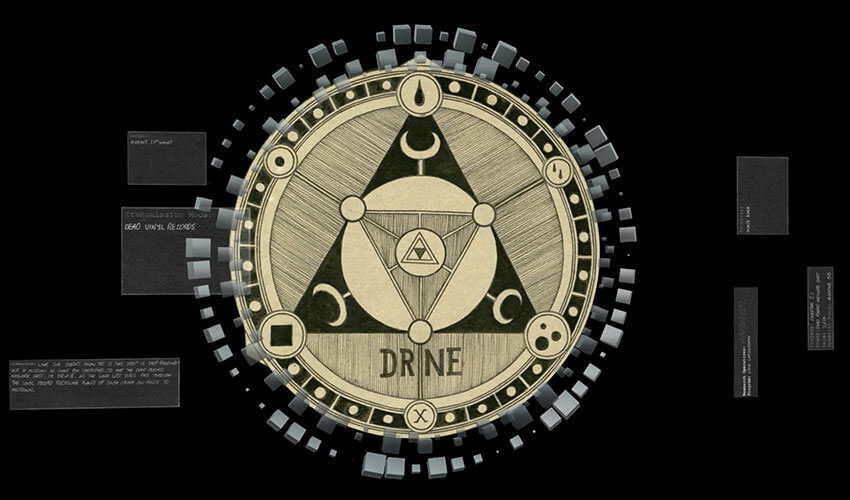Text by Meritxell Rosell

Sound- similar to light- operates in the spectrum of what’s perceivable by human beings and what’s imperceptible. For as long as recording and communications technologies have existed, the potential of this vibrational spectrum that connects sound to infrasound, ultrasound and other inaudible frequencies (what it’s called the Unsound) has been evoked to access anomalous zones of transmission between the realms of the living and the dead, giving insights into the unknown aspect of perception as well as their potential effects on people.
AUDINT – an abbreviation of Audio Intelligence – is a research cell that has been conducting theoretical and artistic experiments at these peripheral zones of sound, investigating at the same time their impact on psychological and physiological states. AUDINT originally formed in the immediate aftermath of the Second World War.
During the chaos of global reorganisation, small splinter cells were formed in the U.S. and UK to research asymmetric warfare modes. One of these cells was named AUDINT. It was composed of ex-members of the Ghost Army – the division’s nickname officially known as the 23rd Headquarters Special Troops. AUDINT’s specific remit was to research frequency-based modes of influence, manipulation, and torture.
The current iteration, the third wave of AUDINT, consists of Patrick Defasten, Steve Goodman, Eleni Ikoniadou, Toby Heys and Souzanna Zamfe. The group share that there has been a number of iterations of AUDINT since 1945. The first wave consisted of Hypolite Morton, Bill Arnett and Walter Slepian who all worked under the direction of Colonel Hilton Railey. As part of the 3132 Signal Service Company Special within the Ghost Army, they were the troops directly responsible for orchestrating sonic deception. Months after AUDINT was formed Morton, Arnett and Slepian were joined by the imported German audio engineer named Eduard Schüller. The second wave of the sonic research unit occurred during the era of the Vietnam war with the arrival of new members – Vietnamese scientist Nguyễn Văn Phong, Marshall Spector, and Magdalena Parker, a Chilean performance artist and filmmaker.
Regarding the relevance of AUDINT’s work, if the U.S. government were to produce a dossier on the weaponisation of unsound and its deployment into the public consciousness, it might start with an entry pertaining to a country with which it has long had issues.
In a period that lasted from August to December 2017, the State Department of the USA began propagating information relating to so-called mysterious sonic attacks on its diplomats at the American Embassy in Havana, Cuba. An array of puzzling symptoms in the victims of the alleged attacks was circulated, ranging from deafness to mild traumatic brain injury. Then, in October, a recording purporting to have captured the high-pitched sound of the supposed frequency-based weapon was made public. For the Whitehouse, hearing was believing.

Given the inconsistent array of symptoms cited, it often appeared that some U.S. Government aid had set free a deep learning algorithm to trawl the internet and retrieve a grab bag of unrelated, yet causally unprovable ailments. From its scrapings, enough information was withheld each time a public statement was made by the press office to ensure that grounding, in fact, was always one step out of reach. As waves of conspiracy theories started to emerge online, including malfunctioning surveillance technologies, and Cuban and Russian espionage, reporters from the mainstream media, including CNN, Reuters, the BBC and the New Scientist began contacting members of AUDINT.
Due to the team long-term research into inaudible frequencies made them an obvious choice for a globalised press that was looking for verification of the Whitehouse’s communiqués. More than this, members of the research unit started working with an internal think-tank, consulting a Cuban government that was/is confounded and concerned by the accusations that have had significant economic and political ramifications for the country. The current group’s output to date has taken multiple forms, including tape and LP editions, computer software, art installations, performances, books, and films.
This week they are presenting a new installation at MIRA festival in Barcelona, accompanied by a talk on Thursday. The installation, Obsidisorium is a multi-sensory installation that expands AUDINT’s Unsound : Undead anthology into an augmented/diminished immersive experience. The installation reveals how waveforms create new dimensions in which the real and the imagined (fictional, hyperstitional, speculative) bleed into one another, where actual sonic events collide with spatiotemporal anomalies and time-travelling entities, and where the unsound serves to summon the undead. In Unsound : Undead (published in Urbanomic 2019), contributors from a variety of disciplines chart these undead zones, mapping out a nonlinear timeline populated by sonic events stretching from the 8th century BC (the song of the Sirens), to 2013 (acoustic levitation), with a speculative extension into 2057 (the emergence of holographic and holosonic phenomena).
For their talk, AUDINT’s presentation will explore their research topic further. Themes of hauntology have inflected the musical zeitgeist, resonating with the notion of general cultural malaise and reinvestment in traces of lost futures inhabiting the present. This undead culture has already spawned a Lazarian economy in which Tupac, ODB, and Eazy-E are digitally revivified as laser-lit holograms. The obscure otherworldly dimensions of sound have also been explored in the sonic fictions produced by the likes of Drexciya, Sun Ra, and Underground Resistance, where hauntology is virtually extended: the future appears in the cracks of the present. Exploring augmentation and virtuality outside the visual realm, delving into the unheard sonic territory.






